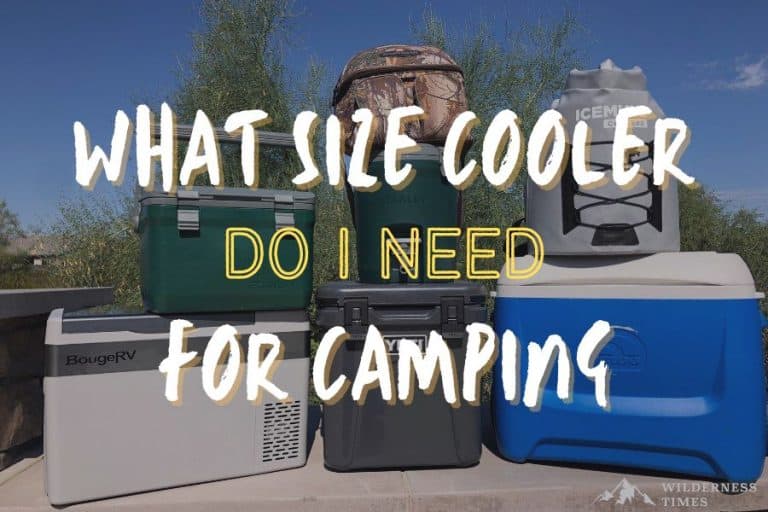Food plays a big part in making any camping trip enjoyable.
But to enjoy nice meals when you’re out in the wilderness, you’ll need a cooler to keep them fresh.
Now, the real question is – what size?
There are tons of sizes available, so that’s a legit question, and we’re going to answer it today.
In this article, I’ll share with you everything there is to know about cooler sizes, as well as features that can help you make the decision.
Let’s dive straight in.
Table of Contents
ToggleWhat Size Cooler Do I Need for Camping?
One thing that’s pretty clear is that you absolutely need a cooler for your camping trip. Now, the actual question is – what size?
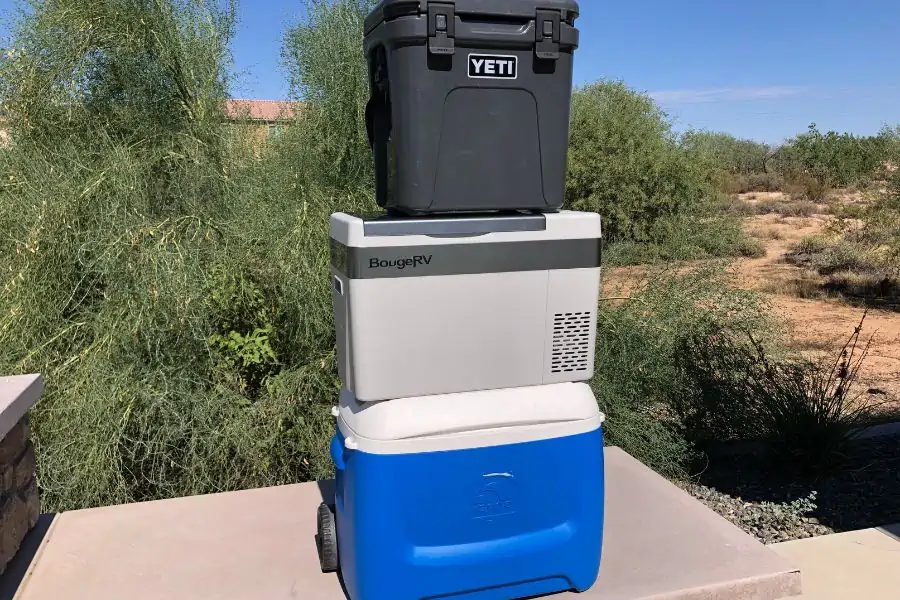
And it might sound trivial, but think about it. If you bring a cooler that’s way too small, you won’t be able to pack all the food you’ll need for the trip.
On the other hand, if you go with a cooler that’s too large, you’ll have to use more ice to keep the food inside cool.
The capacity of coolers is usually measured in quarts (or liters, when sold in countries that use the metric system).
And I am not going to lie, these units aren’t intuitive.
For quite a long time, I would have to check out the dimensions of the cooler to get an idea of how big it is.
In some cases, the brands will tell you how many beer cans you can fit inside a cooler.
Personally, I find that “measurement” much easier to visualize.
But of course, turning those beer cans into food packaging of different shapes isn’t always as simple.
What Size Cooler Do I Need For 1 Person?
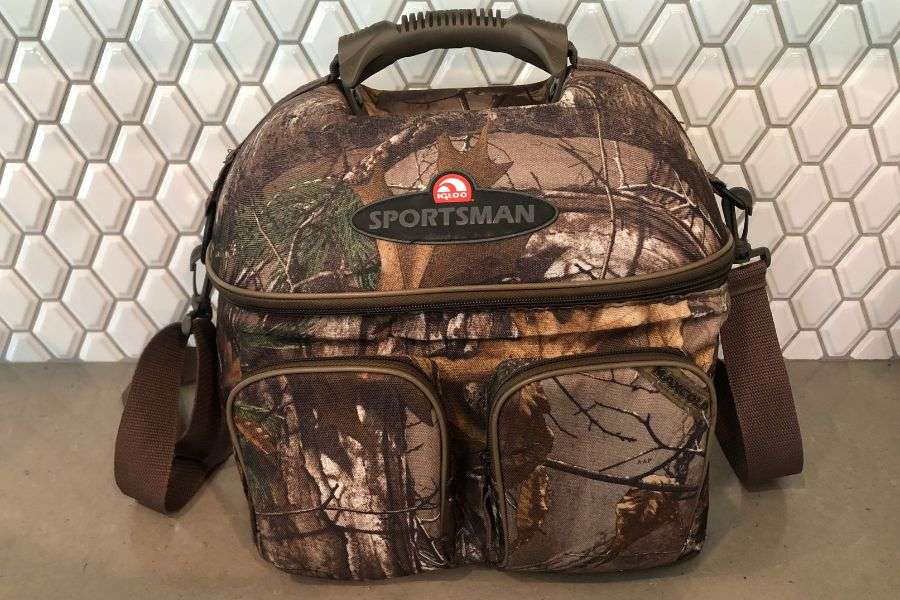
Camping solo? Then, a small or medium-sized cooler is your best option.
First, you won’t need a large cooler to store everything you’ll be eating on your trip.
And second, even if you are car camping, you’ll still have to carry all of your gear at least some distance.
Generally, a cooler with up to 20 quarts of capacity should be more than enough for your trip.
The smallest option is 8 quarts, which roughly translates into 10 cans of beer.
A cooler of this size should be enough for a one or two-day trip.
If you’re staying for longer, or simply need more space, then by all means go up a few sizes.
Generally, a 20-quart cooler is like the upper limit you’ll need when camping alone.
You can fill it with enough food and drink, while still keeping it relatively lightweight to carry around.
What Size Cooler Do I Need For a Couple?
If a cooler between 8 and 20 quarts is enough for a single person, then it’s no rocket science figuring out the size for a couple.
You want to double that amount, but also leave a bit extra for more ice.
Because the more stuff you have, the more ice you’ll need to chill it down.
Therefore, I’d recommend going with a cooler that’s between 20 and 40 quarts.
These are considered to be small to medium-sized coolers.
A 20-quart cooler can fit roughly 16 cans of beer inside.
That should be plenty of space for food and some drinks for an overnight or weekend escape into the wilderness.
But let’s not forget you’re going with your significant other.
If you want to turn your camping trip into a romantic date in nature, you might want to bring wine, champagne, or picnic foods.
In that case, consider bringing a slightly larger cooler that can accommodate all that.
A cooler with 40 quarts of capacity are a bit on the larger side, but can fit tall bottles as well as other things.
Just keep in mind that coolers of this size aren’t exactly light.
Depending on the material and insulation, they can weigh roughly between 15 and 25 pounds – when empty!
So when you add the weight of your food and drinks, as well as ice, that turns out to be quite heavy.
What Size Cooler Do I Need for a Family?
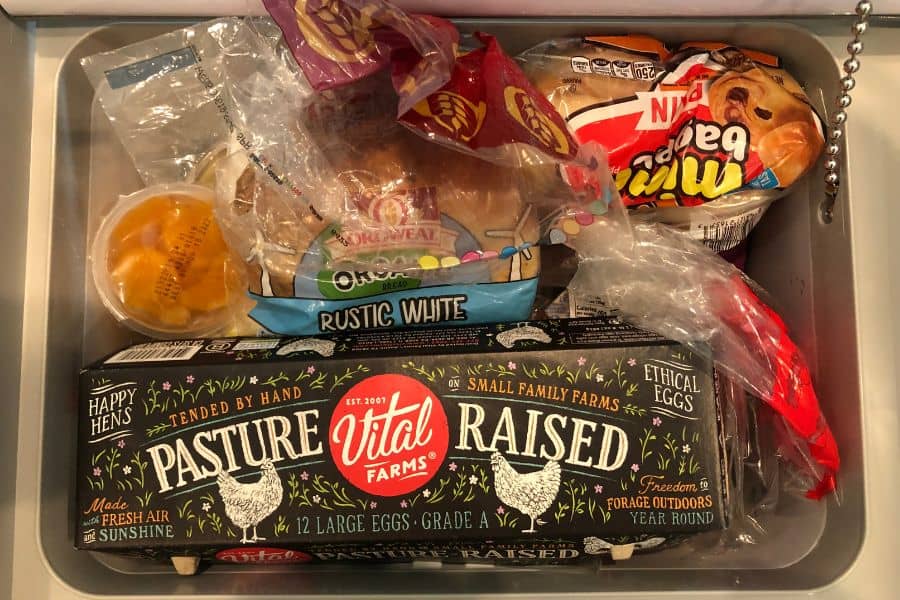
So for families, do we just multiply the number of members and get the number of quarts you need in a cooler?
Well, that’s not that simple.
If you’re going camping for a day or two, you might actually squeeze your food and drinks into a 30 to 40 quart cooler.
But a much better option would be to bring two smaller ones. One would be just for food, and the other for drinks.
Why you might ask?
Well, the more often you open the cooler to take out something, the more cool air will escape.
And while you will probably open your food cooler only when you’re making a meal, the cooler filled with drinks will be used multiple times a day, by all family members.
The more often a cooler is opened, the more likely it is you’ll need to replenish ice to keep everything cold.
Therefore, two coolers with roughly 20 to 30 quarts should be enough for a family of four on a two-day trip.
If you’re camping longer than that, you might want to choose a larger cooler for your food.
A 45-quart cooler can fit about 36 cans inside, so there’s plenty of space for all you need to prepare meals in nature.
Again, you should keep weight in mind when choosing a cooler.
Even when empty, a cooler of this size can weigh 30 pounds and more. That’s not something you can easily carry around.
Luckily, you can find models in this size with wheels, so you can simply roll it from the car to the campground.
This is definitely a feature to consider if you’re carrying a ton of camping gear as well.
The Different Sizes of Coolers
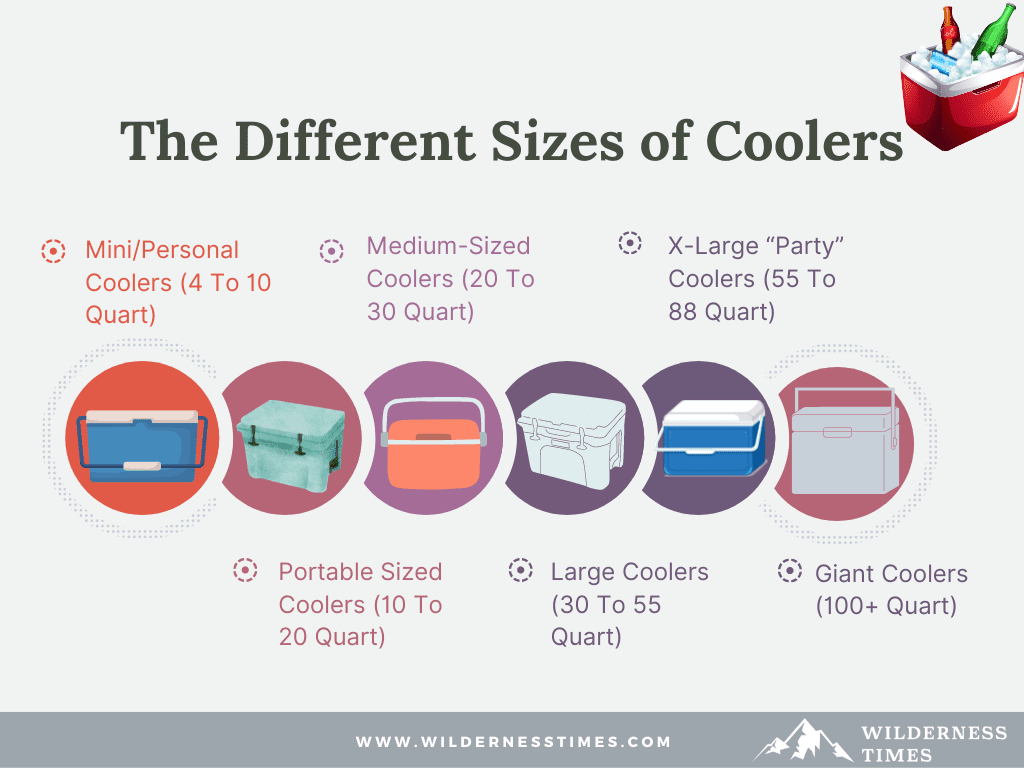
As you see, coolers sizes are indicated in quarts, which can also be roughly translated into the number of beer cans.
But, that doesn’t mean you should actually fit that many cans inside.
Ideally, you want to fill up ⅔ of the cooler with ice, and only ⅓ with food and drink. Otherwise, your cooler won’t be able to keep your stuff cold for very long.
Of course, this doesn’t apply to electric coolers like the BougeRV Portable Refrigerator. This type of cooler uses a power source, just like a real fridge, to chill down its content.
So there’s no need to use up the space inside with ice.
So with electric ones, the number of beer cans is a pretty accurate way of measuring.
But with standard coolers, you have to consider everything that goes in, including ice.
Mini/Personal Coolers (4 to 10 Quart)

Let’s start with the smallest cooler available – the 4-quart one. This cooler is practically a lunchbox.
In terms of dimension, it’s no bigger than a six-pack of beer.
A 10-quart cooler isn’t much larger. The exact size depends on the brand, but generally, 10-quart coolers have no more than 15 inches in length.
And as far as weight goes, mini hard-sided coolers are usually below 10 pounds.
This means you can easily carry it around holding it by the handle.
There’s one thing to keep in mind. With just an item or two in a cooler this size, there’s already little space left for ice.
Plus, the majority of mini coolers on the market are soft-sided.
Therefore, don’t expect your mini cooler to keep your food or drink chilled for days.
But with proper seal and insulation, it should take a whole day for ice to melt.
Small Portable Sized Coolers (10 to 20 Quart)
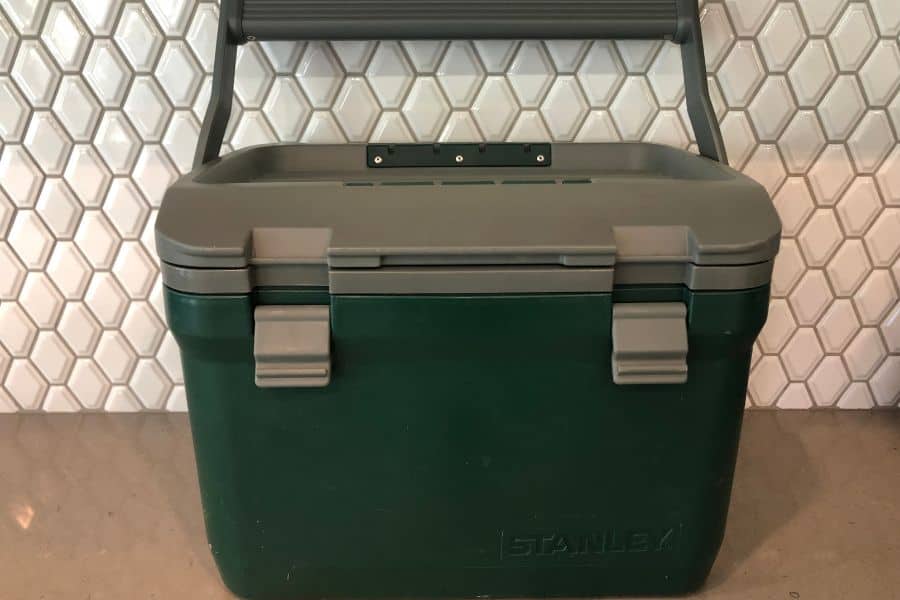
In this category, we have coolers between 10 and 20 quarts of capacity. Or to put it this way, that’s between 12 and 24 cans of beer.
Or, if you prefer wine, that’s roughly 4 bottles you can fit inside.
I can’t give you the exact dimensions of these coolers, as different models have different shapes.
While most are rectangular, some have a more square shape. But let’s say that a rectangular-shaped 20-quart cooler should be roughly 20 inches in length.
While 10-quart coolers usually feature a carry handle, the 20-quart ones often have a shoulder strap as well.
That’s because hard-sided models with this capacity can weigh more than 12 pounds when empty.
Once filled, that can be tough to carry.
Medium-Sized Coolers (20 to 30 Quart)
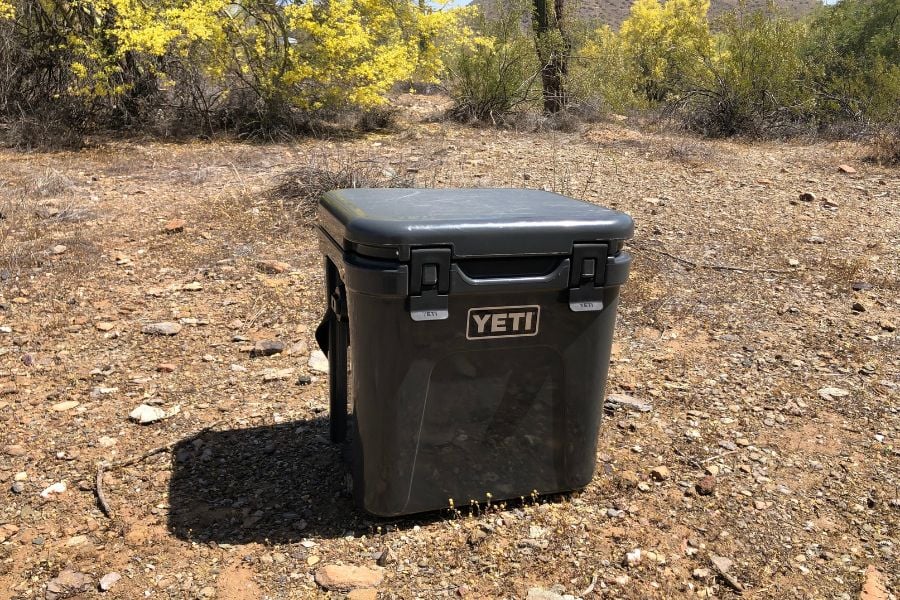
Medium-sized coolers are quite versatile. They’re suitable for families and groups camping overnight.
Furthermore, they’re also great for solo campers on several day’s long trips.
A cooler with a capacity between 20 and 30 quarts is the perfect middle ground.
They’re compact enough to store in your trunk along with other camping gear.
At the same time, they’re big enough to utilize a 2:1 ice-to-content ratio for optimal performance.
Even when filled, medium-sized coolers aren’t too heavy for a single person to carry them. Of course, I’m not talking about backpacking.
But you shouldn’t have trouble carrying it out of the trunk and to your campsite.
In this size range, you can find both soft and hard-sided coolers. While the former win in portability, the latter has much better ice retention.
The choice between the two comes down to which one is more important.
Large Coolers (30 to 55 Quart)
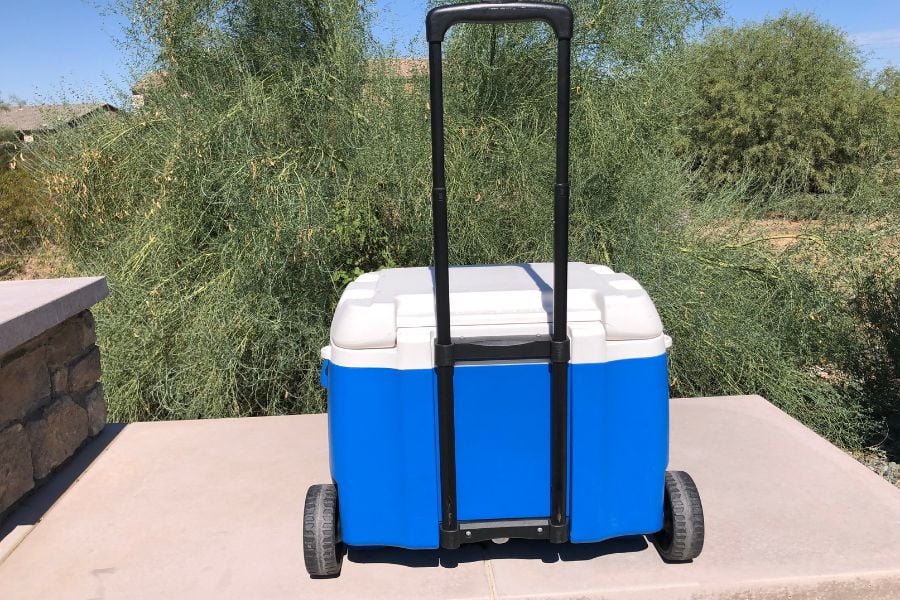
Coolers with a capacity of over 30 quarts tend to be quite bulky and heavy.
If you’re a solo camper, you’d probably struggle to carry such a cooler to your campsite, unless it has wheels so that you can simply roll it there.
If weight is not an issue, and you’re camping with friends or family, this is definitely the category to consider.
Most large coolers allow you to store bottles in an upright position, so you can make the best use of the interior space.
This size range of coolers is suitable for different occasions.
Aside from a few day-long camping trips, they’ll also great for barbecues in public parks.
Since you only need it to keep your stuff cool for the duration of the day, you can use less ice, and add more food or drinks.
X-Large “Party” Coolers (55 to 88 Quart)
For groups of four and more campers, the so-called “party” coolers, which range between 55 and 88 quarts, are definitely worth considering.
We’re talking about 60+ cans of beer fitting in there.
This is the size range of coolers deer hunters commonly use for their kills.
Now, if it can fit a whole animal inside, it definitely can store your consumables as well.
If you follow the 2:1 ice-to-content ratio, an x-large cooler should have enough ice to keep your food and drinks cool for days.
With high-quality models, we’re talking about a whole week before ice melts.
I must warn you, these coolers are pretty heavy. Even when empty, they weigh 30 pounds or more.
But once you fill them with ice and food, the numbers will only go up.
Don’t try carrying an x-large cooler by yourself.
In fact, with a handle on each side, it’s clear that coolers this big are designed to be carried by two people.
With that being said, certain models come with wheels. So while you can’t carry it by yourself, you can roll it all the way to your campsite.
There’s another thing to keep in mind. If you own a small car, a cooler this large can take up almost the entire trunk space. Go smaller in that case.
Giant Coolers (100+ Quart)
Finally, we have the giant category, featuring coolers with a capacity of over 100 quarts.
I know, they’re huge. They’re 160+ cans of beer huge.
These coolers are mainly aimed at big game hunting and deep-sea fishing.
But if you’re camping with the family for a week or more, then a cooler this size will surely serve the purpose.
Now, I’ve seen models in this size range weighing as much as 40 pounds when empty.
While there are models without wheels, I’m a big advocate for those with them.
You don’t want to break your back carrying a cooler around, even if you have the help of another person.
Key Factors When Choosing a Size
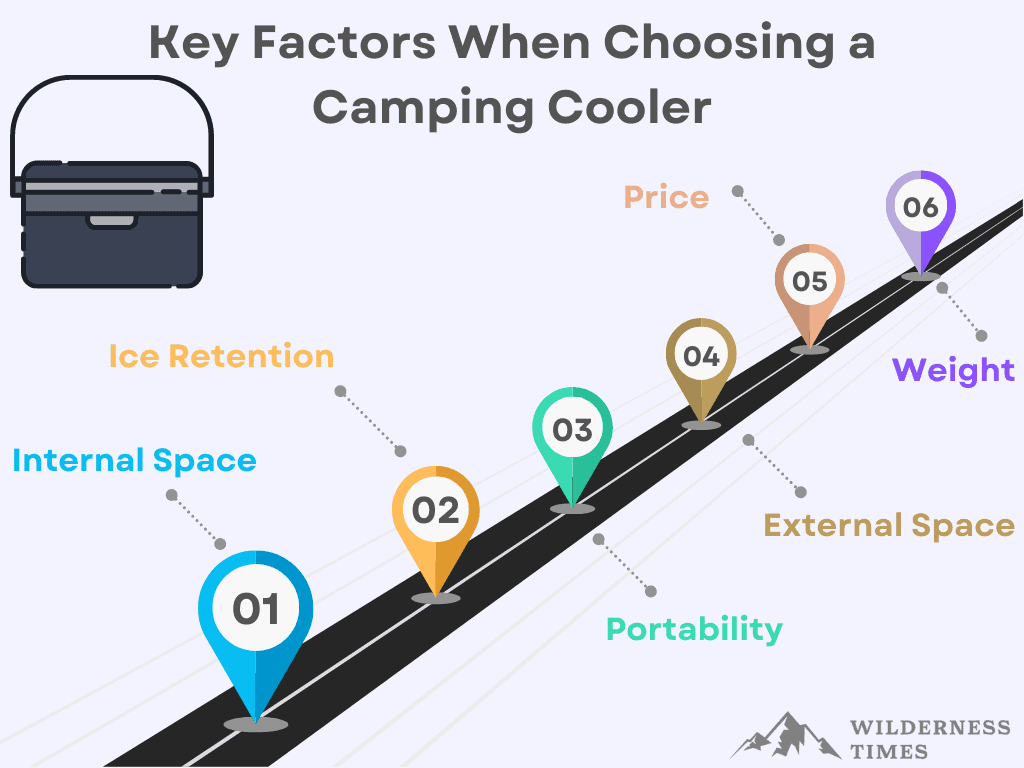
Picking a proper size isn’t that simple. There are several factors that can affect your choice, and in this section, we’ll discuss each in detail.
Internal Space
First and foremost, how much storage space do you actually need?
Remember, you need to take into account the amount of space ice takes up. Ideally, you want a 2:1 ice-to-content ratio.
Therefore, only one-third of a cooler will be filled with your consumables.
Of course, you can always add even more ice. What that will do is keep your food and drink cold for even longer.
Ice Retention
Aside from the previously mentioned ice-to-consumables ratio, there are other factors that have a big impact on how long it keeps ice solid.
First is the insulation. Generally, foam is used as it’s very efficient.
But while affordable coolers typically use styrofoam, more high-end products use polyurethane foam, which is a much better insulator.
To keep a steady temperature, a cooler needs to be sealed correctly. Once closed, no air molecules should be able to get inside the cooler.
To ensure that, you want a model that has latches to prevent the lid from opening at any point.
Portability
The larger the cooler, the heavier it gets. And certain models can weigh more than four bowling balls when empty.
Once you fill it up, moving it around becomes quite a task.
With small coolers, a simple carry handle will do the trick.
But with larger models, look for handles on both sides, so that another person can help you carry it.
In the case of 50+ quart coolers, having wheels is a life changer.
Not only do they allow you to move the cooler on your own, but you don’t have to break your back to reach the campsite.
External Space
With high-quality hard-sided coolers, the insulating layer is a few inches thick.
And therefore, the external space of a cooler can be much larger than its capacity.
And sure, thicker insulation means longer ice retention. But who wants a cooler with 7-inch thick walls?
On the other hand, soft-sided coolers have pretty thin walls. And for that reason, they don’t retain temperature that well.
Basically, you should find the right balance between the two.
Price
The price is always a relevant factor when deciding on what to buy.
Generally, the bigger the cooler, the higher the price.
But, that might not always be the case. A 20-quart cooler from a premium brand can be more expensive than certain 50+ models.
Then again, a more high-end brand will probably have certain features that improve its performance, such as good insulation.
Personally, I believe that investing a few hundred into a good cooler is well worth it.
With proper care, it can last you a very long time.
Weight
It’s pretty clear that soft-sided coolers are much lighter than their hard-sided counterparts.
While the former usually has a vinyl body, the latter is made of thick plastic.
Therefore, there will be at least a few pounds of weight difference between the two types of coolers.
And of course, the larger the cooler, the more it weighs.
When choosing a model, make sure you’re able to carry it comfortably.
If not, look for a model with wheels, which will make moving it much easier.
Features
Even the tiniest details can affect your final decision.
Portable coolers can have some pretty interesting and practical features that make them stand out from the crowd.
One feature I believe every cooler should have is the drain plug.
Located at the bottom of the cooler, the drain plug allows you to get rid of melted ice inside without a hassle.
Dry storage dividers are also very handy. They allow you to keep sensitive food away from the ice, such as fruit and veggies.
When not needed, you can remove the dividers and have a single section instead.
Maybe less important, but still very practical, are features like a built-in bottle opener and cup holders.
If you like fishing while camping, you might like having an integrated ruler on the top of the lid, so that you can measure the fish you caught.
Cleanability
You definitely want to take into consideration the cooler’s cleanability.
Of course, you won’t know this ahead of time, but you can get a general idea based on the materials or fabrics used.
In general, the more moving parts, the harder it will be to clean.
Electric coolers will be harder to clean since you’ll need to avoid the electronic components.
Soft coolers are going to be harder to clean since they have various fabrics that may not be able to be washed.
On the other hand, a hard-sided cooler with little to no features is going to be easy to hose off, wipe down, and store.
Also See: How to Clean a Camping Cooler: Get Rid of Smells, Gunk & Mold!
Coolers That We’ve Tested on Camping Trips
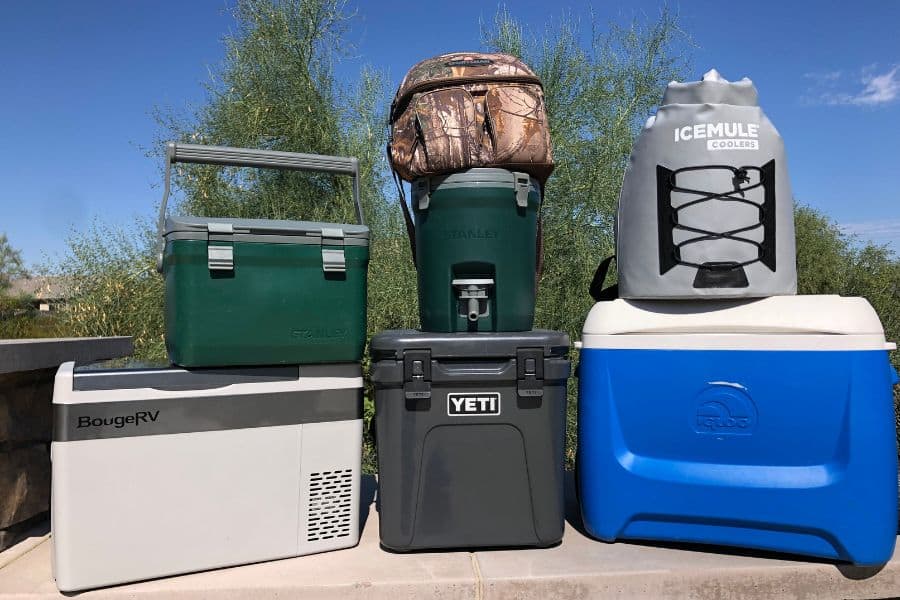
Over the last few years, we’ve had the opportunity to use many different coolers.
To put them through the test, we’ve taken then on family camping trips, road trips, day trips, Disney trips and more.
From unbearable summer heat to wet to cold winter days, my family and I have really gotten to see how different models perform in all situations.
Some of the coolers we’ve tested are:
- Bodega 37 Quart Electric Cooler
- BougeRV 30 QT Portable Refrigerator
- IceMule Pro
- IceMule Urbano
- IGLOO 40QT Wheeled Cooler
- IGLOO Sportsman Personal Cooler
- Pelican Elite 45 Quart Wheeled Cooler
- Stanley Adventure 16 QT Easy Cary Cooler
- YETI Roadie 24
They all have various strong points and weaknesses, but our go-to has been the YETI Roadie 24.
In fact, I can’t seem to find a better one for most of the situations I’m going to list in the section below.
Best Cooler for Going Light
If you’re going on a day hike, you can’t go wrong with the IceMule Pro.
It’s large enough to carry well over a day’s worth of lunch and drinks, but it won’t weigh you down a lot, because the bag itself is extremely lightweight at 3.5 lbs.
For a soft-sided cooler, I must admit this model performs exceptionally well.
Thanks to the thick insulation and leakproof design, this cooler stays cold for up to 24 hours.
With proper care, this cooler can last a pretty long time, though be careful putting TOO much in on a hike as it can get heavy fast
Best Cooler for Day Trips
What makes Yeti Roadie 24 so great for a day trip is its shape.
It’s built tall, so you can store your wine bottles (or milk for the kids) upright in it. It’s also thin, allowing you to place it behind the driver’s seat of your car.
That way, you have more room in the trunk for actual camping gear.
This cooler is built like a tank. Pressure-injected insulation and interlock lid system ensure the cold is locked in and heat blocked out.
It’s built so tough, and is tall enough that the cooler can also function as a stool or a be used as a ladder to fetch something up high.
Best Cooler for Paddling Trips
For paddling or kayaking, the IceMule Pro Cooler is a tough one to beat.
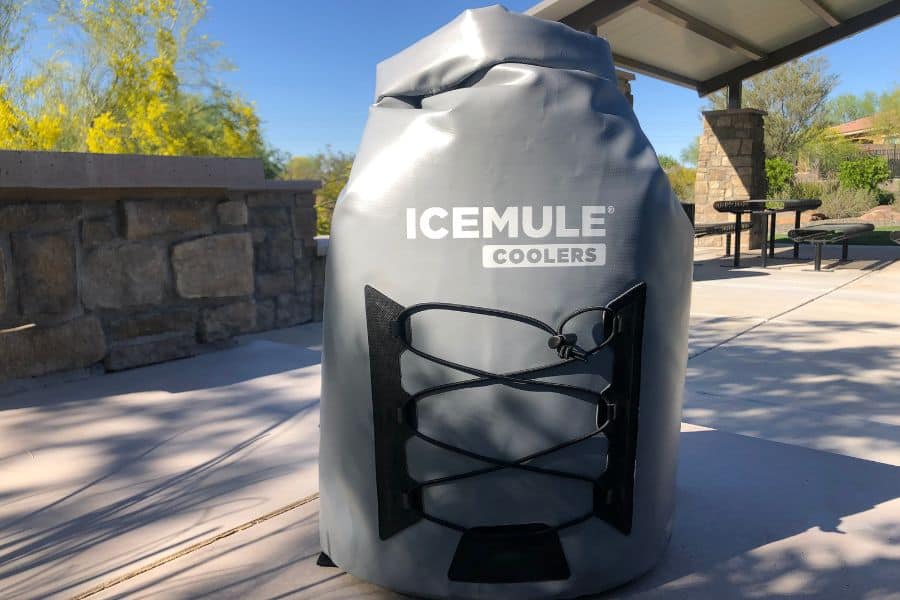
Designed like a backpack, this cooler leaves you hands-free whenever that’s needed.
The padded straps and back pads make this cooler quite comfortable to wear.
Of course, what makes it so great for water activities is the waterproof design.
Neither the water can get in, nor melted ice can get out of this cooler. And most importantly, it keeps your stuff cold for at least 24 hours.
Best Cooler for a Day at the Beach
For the same reasons as above, the Ice Mule Pro is the best soft cooler to pick for when you’re spending the day at the beach.
Aside from water, the roll-top opening also prevents sand from getting inside.
The double layer of waterproof nylon sandwiches the insulating foam, allowing your food to stay cold for longer.
Even in summer temperatures, this cooler is capable of keeping your food chilled for two days or more.
Plus nothing is worse than lugging a cooler over sand, and this is prevented by using a backpack cooler.
Best Cooler for a Weekend Camping Trip
For a weekend trip, we take both the Yeti Roadie 24 and the BougeRV Electric.
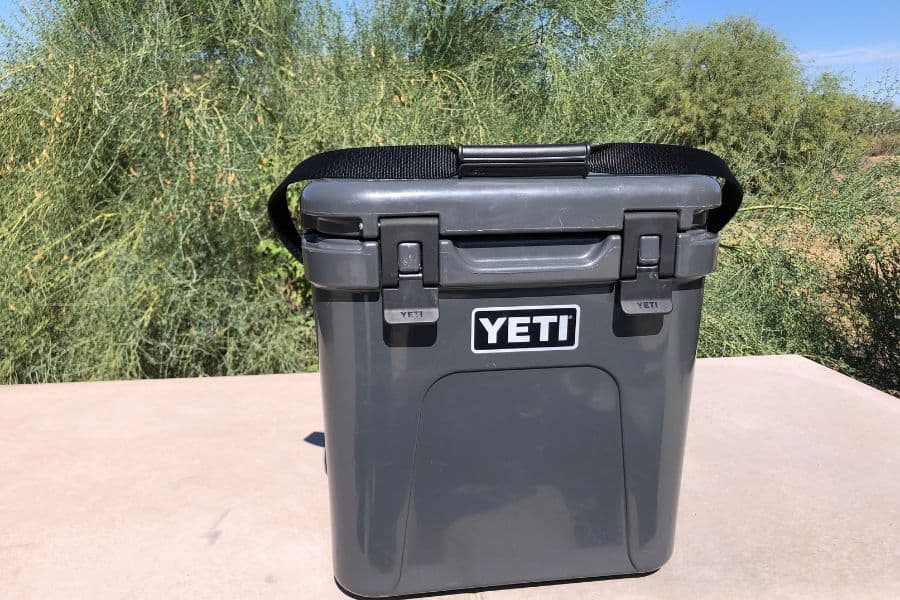
The Yeti Roadie 24 has plenty of space for all your food and drinks, and good enough insulation to keep them chilled for days, even during triple-digit outdoor temperatures.
The bearproof design means you can use this cooler even when camping in grizzly country.
All in all, it’s a very reliable cooler in terms of both insulation and durability.
The BougeRV Electric is another great option for a weekend camping trip if you’re traveling by car.
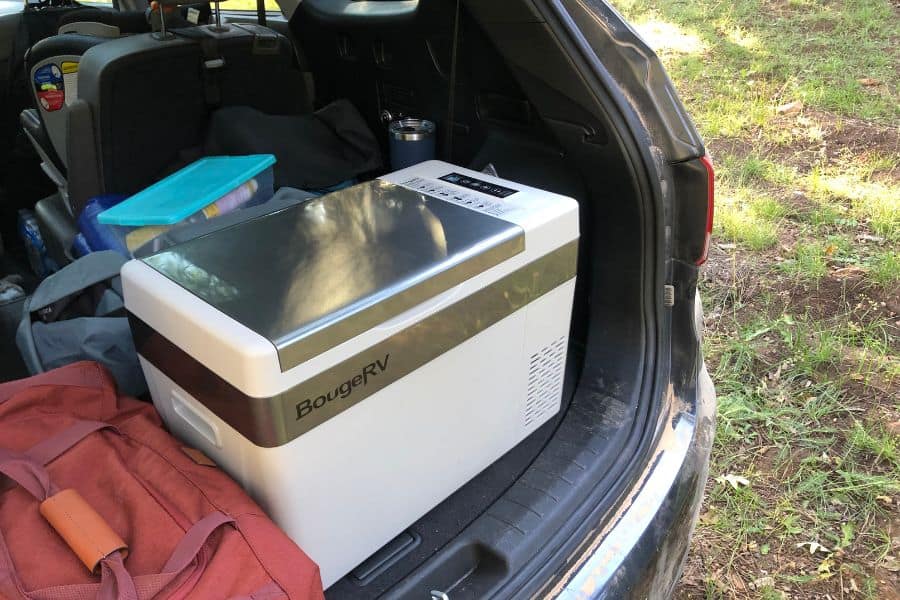
You can charge it with the 12V cigarette lighter adapter (when driving), and the with a good power station like the EcoFlow Delta 2, we’ve been able to power our 12-volt Portable Refrigerator for up to two days.
Especially if you turn on the power-saving mode.
Without ice, there’s plenty of space for all the consumables you need on your trip.
You can also set up the desired temperature, depending on what’s inside.
Best Cooler for the Whole Family
The Yeti Tundra 45 is going to be perfect for the job.
The 45-quart capacity is more than enough for storing food and drinks for the entire family.
The durability of this model is quite impressive. In fact, it’s sturdy enough to serve as a bench when you want to stay away from the ground.
While it’s a rather large cooler, the rope handles make it easy to move it around.
In fact, if not fully loaded with heavy cans, you can even carry it yourself if needed.
FAQs
How big should the camping cooler be?
That depends on the size of the group and the length of your stay.
For a single person or a couple camping for a day or two, go with a cooler with a capacity of between 10 and 20 quarts.
For a group of four, a 30 to 45 cooler should be enough for a few days, but you can always simply bring two coolers as well.
How much can you fit in a 45-quart cooler?
A cooler of this size should hold about 34 beer cans with ice.
Or to put it this way, that’s roughly enough food and drinks for a three-day camping trip.
Is a 20-quart cooler big enough?
A 20-quart cooler is just enough for one person on a weekend trip, or two people overnighting in nature.
What is the most common size cooler?
Large coolers, which range between 35 and 55-quart capacity, are most commonly used.
They’re suitable for families and groups and can hold enough food and drinks for a couple of days.
To Sum Things Up
Coolers come in a variety of sizes, from lunch boxes to barely fitting into your car trunk.
So when choosing the right size for you, there are certain things you need to take into consideration.
From logical factors, such as weight and price, to specific features that make a model unique, you should find a cooler that suits your need.
Hopefully, this article covered everything you need to know to make an informed decision.


